
(Vienna, 31-01-2019) New, targeted therapies aimed at genetic mutations or specific receptors increasingly require better molecular tumour characterisation in cancer treatment. The biology of tumour cells is constantly changing due to mutations, making it extremely important to have a non-invasive diagnostic technique that can accurately map these changes. That is precisely the aim of the Christian Doppler Laboratory for Applied Metabolomics, which was opened at MedUni Vienna today, Thursday. It will be headed up by nuclear medical specialist Alexander Haug and pathologist Lukas Kenner. Using Positron Emission Tomography (PET) in conjunction with fine tissue tumour analysis, the aim is to identify the specific metabolic "fingerprint" of relevant genetic changes in the tumour. The pattern that is obtained will act as a tumour "map", so that patients can receive tailor-made, personalised treatment in the context of precision medicine.
"Although Positron Emission Tomography is well established within oncology, only a fraction of its enormous potential is currently used – and indeed it is not used at all in conjunction with pathology. That's something quite unique," explain Haug and Kenner. "In our new CD Laboratory for Applied Metabolomics, we want to combine PET imaging, histopathological tests, analyses of genetic mutations relevant to treatment and prognosis plus clinical data such as survival and treatment response. Our aim is a non-invasive 'in vivo pathology' that ultimately results in a personalised treatment algorithm.
Combining both disciplines to provide an optimal analysis tool
To this end, an Artificial Intelligence tool for "Supervised Machine Learning" is being used to identify the tumour characteristics and the associated treatment response from analysis of the available PET data – these data then being compared with the pathology results. Within the 7-year term of the CD Laboratory, it should in future be possible to identify, just from looking at this tumour "map": 1) whether the tumour is malignant; 2) if so, what kind of tumour it is and 3) how this tumour is best treated in this patient in the context of precision medicine.
"That is the advantage of combining these two disciplines: pathology can identify every minute protein activity under the microscope, while PET gives us the big picture. The better we know and understand the tumour and its mutations, the better we can treat it. This innovative technique shows up specific patterns in PET, which we can then catalogue in a tumour index," explain the MedUni Vienna researchers. Subsequently it will be possible to search for similar tumour patterns in a "rogues' gallery" and then act accordingly. The results from the retrospective part of the project are being validated in preclinical mouse models.
In a first step, the following types of tumour are being investigated: colon cancer, diffuse large cell B-cell lymphoma and prostate cancer. Later on, the study will be expanded to include breast cancer and non small cell lung cancer.